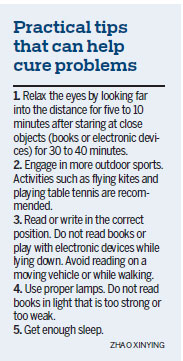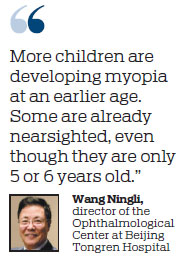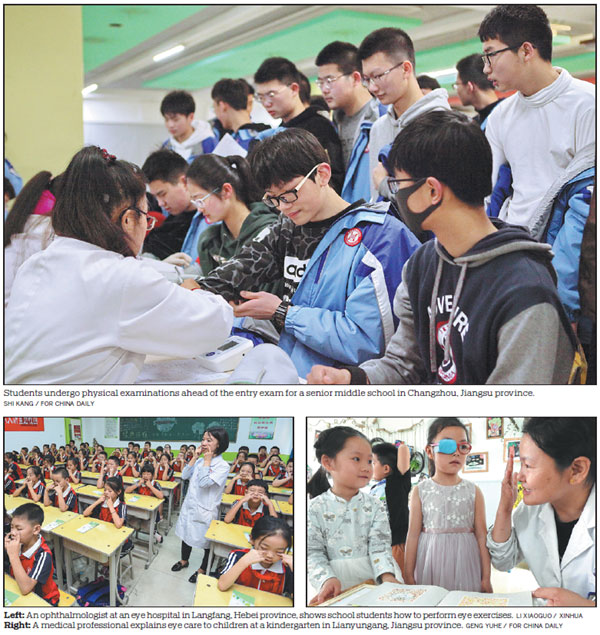Authorities eye ways to prevent childhood nearsightedness
World Health Organization report says China has the world's highest rate of adolescent myopia. Zhao Xinying reports.
Like many nearsighted people, the first thing Chen Xu does when she wakes in the morning is grab her glasses and put them on.

Other people might say the first thing should be to dress or brush her teeth, but Chen disagrees. She doesn't want her first view of the world every morning to be blurred.
The 35-year-old, who teaches English at a junior middle school in Shanghai, started wearing corrective lenses when she was about the same age as the 13-to 15-year-old children she teaches.
"At first, my nearsightedness was only-3 or-4 diopters (a low level). It then grew with my educational background," joked Chen, who has a master's in education studies. "Before I graduated from college in 2006, it had risen to-7 diopters and has stayed at that level ever since."
Recalling spending her adolescence at her desk - often for hours without even a short break - to finish assignments or read novels, she said: "The academic workload was just too heavy at the time. As far as I am concerned, most people my age became myopic at about the same age as me and for the same reason."
Things don't seem to have improved. A 2016 report by the World Health Organization showed that with 600 million nearsighted people - almost half the population - China has the world's highest rate of adolescent myopia.
More than 70 percent of high school and college students and almost 40 percent of primary school students have problems with their eyesight.
Li Aoyu, chief ophthalmologist at the Eyecare Beaucare Clinic, a private hospital in Beijing's Chaoyang district, has worked as an optometrist for decades. In recent years, he has noticed a change in the age of the patients coming to see him.
"Primary school students now account for at least one-third of my patients. It's an obvious rise." he said. "There were not so many before."
Wang Ningli, director of the Ophthalmological Center at Beijing Tongren Hospital, a public hospital renowned for eye treatment, has also noticed the trend.
"More children are developing myopia at an earlier age. Some are already nearsighted, even though they are only 5 or 6 years old," he said.
Factors and hazards
Yang Yiwei, a nearsighted 18-year-old high school student in Tianjin, got her first pair of spectacles five years ago.

"She was obsessed with all types of electronic devices, whether televisions, computers, or mobile phones," said Xie Hui, Yang's mother.
The family relocated to Tianjin in 2013 when Yang became a junior middle school student. As an introverted young woman, Yang didn't like making friends in the new environment.
"She chose to stay home all day during that period, watching TV and surfing the internet," Xie said, describing how her daughter started wearing glasses.
Li said nearsightedness is caused by a combination of genetic and environmental factors, but most people with a low level of nearsightedness usually develop the condition by focusing on close objects - whether it's a book or an electronic device - for too long.
This makes the muscles in the eyes too tense to change the shape of the lens, a convex structure in the eye. If that muscular tension is maintained, the diameter of the eyeball will grow irreversibly and people will gradually develop true myopia, he said.
"True myopia cannot be cured," Li said. "It can only be rectified. So, prevention is very important."
A 2015 Peking University report on visual health said China had a nearsighted population of 450 million in 2012. Without effective prevention or control, the report warned, the number would rise to 700 million by 2020.
A large nearsighted population would have an adverse effect on the country's development in some fields, such as the military, aviation and precision instrument manufacture, the report said.
In addition, myopia, as a type of vision defect, can lead to maculopathy (a pathological condition of the area at the center of the retina that is associated with sensitive, accurate vision), cataracts and retinal detachment. It could also add to the financial burden on individuals and the whole country, it added.
Corrective measures
As the leader of a national task force on blindness prevention, Wang, from Beijing Tongren Hospital, participated in the compilation of The Guidebook on the Prevention and Control of Nearsightedness, published on June 6 last year, the 23rd China National Eye Care Day.
Wang and the task force recognized that one of the most effective ways to prevent and control myopia is for children to participate in outdoor activities for at least 90 minutes a day.
"Please note that the activities must be conducted outdoors; those indoors will be invalid," he said.
Additional measures, such as supervising students in "ocular gymnastics", may make a small difference, but more important, all parties - health and education authorities, families and society as a whole - should work together in a coordinated way to reduce the incidence of nearsightedness among children and young students, he added.
Wang Haifeng, the mother of a seventh-grade student in Beijing, fully understood Wang Ningli's remarks.
Her son, Ma Lele, was diagnosed as nearsighted two years ago. By urging him to massage his eyes and play sports such as basketball, she was pleased to find that the young man's nearsightedness didn't worsen over the short term.
However, that situation didn't last long. Ma's eyesight has deteriorated since he started junior middle school in September.
"Homework grew noticeably, often taking two or three hours to finish every night. Worse, he could hardly spare time for physical exercise," Wang Haifeng said, adding that right before the winter vacation ended last month, Ma's spectacles of-2 diopters were "upgraded" to-3.50 diopters.
"As a parent, I often find myself in a dilemma: I can't stop my child from doing homework, but I'm worried about his eyesight," she said.
Improvements
However, things may have started to change for the better.
In August, the Ministry of Education, together with seven other government departments including the National Health Commission, issued a guideline that set a target of capping the proportion of nearsighted children below 38 percent for primary school students, 60 percent for those at junior middle schools and 70 percent for high school students by 2030.
To realize that goal, the ministry has ordered schools to reduce students' academic workloads, provide more light in classrooms, urge children to perform eye exercises, and participate in more outdoor activities.
Provincial education departments have already introduced concrete measures.
As the new semester started last month, teachers in Zhejiang province were barred from assigning homework on electronic devices.
In Fujian province, teachers were told not to assign any homework to first-and second-grade primary school students to reduce their academic workload. Meanwhile, authorities in Yunnan province ordered schools to inspect and monitor students' eyesight at least twice every semester.
These moves were all aimed at paying more attention to students' eyesight and avoiding eyestrain.
Chen, the teacher in Shanghai, said her school has strengthened management to protect students' eyesight.
In the past, she and her colleagues urged students to perform ocular gymnastics twice a day, in the morning and the afternoon.
Now, they have gone a step further by confiscating students' mobile phones when they arrive at school in the morning and returning them when classes finish.
"It may sound a little strict, but we hope to help reduce the time students spend on electronic devices," she said.
Early action
Li, of the Eyecare Beaucare Clinic, said parents should pay special attention to the prevention of myopia before children reach 18, because their eyesight is not fully mature and is vulnerable if strained regularly at an early age.
Those factors explain why most people become nearsighted, or their nearsightedness tends to worsen, in their early teenage years. After 18, a person's eyesight matures and becomes relatively fixed, he said.
Wang Ningli said many people mistake schools - primary, junior middle or high - as the major "battlefields" for the prevention and control of myopia.
"In fact, the battle should start earlier, at preschool," he said, adding that research indicates that children should preferably be equipped with a degree of hyperopia (farsightedness) at kindergarten.
"If they use up that reserve too early, they'll develop nearsightedness after attending primary school," he said.
Chen and her husband Xia Dong share a similar degree of nearsightedness. Xia is working hard for his doctorate, which requires a lot of paperwork, but the 36-year-old doesn't dare sit at his desk for too long.
He gets up and moves around every 30 minutes to set a good example for his daughter to use her eyes properly. The girl is only 7, but she is already unable to see distant objects clearly.
"Her mother and I are a little bit worried. We hope to protect her eyesight - at least, we hope she won't become nearsighted even earlier than we did," Xia said.
Wang Xiaodong contributed to this story
Contact the writer at zhaoxinying@chinadaily.com.cn

(China Daily 03/29/2019 page5)


















